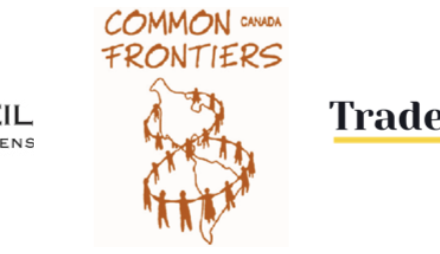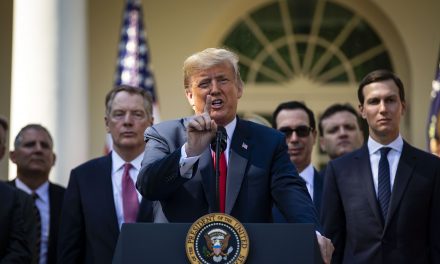Last weekend, US Border Patrol agents used tear gas against hundreds of migrants protesting on the Mexican side of the border with the United States. The men, women and children who were gassed were part of the six thousand asylum seekers who fled violence and poverty in Central America by forming a caravan that has now reached the US border. In a related event, the leaders of the United States, Mexico and Canada will sign the United States-Mexico-Canada Agreement (USMCA) at the G20 summit in Argentina this weekend. The two events are related because the migrants who were gassed at the border are economic refugees who illustrate a major contradiction in these supposed free trade agreements. In order to facilitate ‘free trade’ these agreements violate one of the basic tenets of the ‘free market’: the free movement of labor. Given this reality, the USMCA could be more accurately named the United States Migrant Control Agreement (USMCA).
Like all neoliberal free trade agreements, the USMCA has little to do with free trade and everything to do with facilitating profit generation for multinational corporations. They allow corporations to freely move their capital, profits, raw materials and finished goods across borders, but the one commodity that does not have freedom of movement is labor. Workers are commodities under capitalism, as any economist will acknowledge. Consequently, restricting the free movement of one specific commodity (i.e. workers) to cross borders violates a basic tenet of the free market. But restricting the free movement of workers is essential for boosting corporate profits—and, in addition to signing the USMCA, President Trump has sought to restrict such movement by threatening to build a wall, deploying troops to the border, and using tear gas against migrant job seekers on Mexican soil.
By not allowing the free movement of workers across borders, the USMCA, like the currently existing North American Free Trade Agreement (NAFTA), ensures that corporations can exploit low-wage labor. Under NAFTA, an automobile manufacturer can close down an assembly plant in Detroit and lay-off thousands of workers who were earning $30 an hour and open up a factory in Mexico where wages are only $2 an hour. And while the Trump administration’s token protectionist policies, including aspects of the USMCA, claim to address this issue, in actuality they do nothing to remove the ultimate trade barrier that exists in all free trade agreements: restricting the free movement of labor.
If the USMCA and other free trade agreements were to actually create a free market then workers would, like other commodities, be allowed to move freely across borders to access better-paying jobs. Such a scenario would lower wages in the United States and Canada but raise them in Mexico because the movement of workers to regions where wages are higher would eventually equalize wage levels between the three countries. So instead of auto workers earning $30 an hour in the United States and Canada and only $2 an hour in Mexico, they might earn $15 an hour in all three countries.
While this would serve corporate interests with regard to lowering wages in the United States and Canada, it’s still not as profitable as keeping a surplus of impoverished workers trapped within the borders of countries where wages are often less then $2 an hour. This reality illustrates how neoliberal free trade agreements are not about creating free markets so much as establishing favorable conditions for multinational corporations to maximize profits through access to low-wage labor.
An inevitable consequence of the neoliberal free trade model is the immiseration of millions of people, many of who cannot find jobs, and most of those that do earn poverty-level wages. Not surprisingly, many choose to flee the structural violence that has been imposed on them by undertaking the arduous and often dangerous journey to a country where they might be able to earn a living wage: the United States. The thousands of economic refugees in the migrant caravan that is currently at the US border are merely the latest wave of asylum seekers fleeing oppressive neoliberal free trade agreements.
We only need look at the history of NAFTA to see how this has played out over the past twenty years. Following its implementation in 1994, NAFTA resulted in the dumping of food products by heavily-subsidized US agri-businesses onto the Mexican market—the most devastating of which was corn, the principal food staple in Mexico. Not surprisingly, unsubsidized Mexican farmers could not compete with the imported subsidized US corn, and imports from the United States quickly dominated the Mexican market.
For proponents of NAFTA, this scenario was not problematic. Those Mexican farmers who could no longer compete would, in theory, abandon agriculture and become wage labourers in Mexico’s manufacturing sector and begin purchasing imported food. And Mexican farmers did abandon their lands; in fact, they abandoned them in startling numbers. By 2006, it was estimated that as many as two million Mexican farmers had quit farming.
Many of Mexico’s displaced peasants joined the exodus of other poor people from various parts of the country to cities in northern Mexico that were experiencing a boom in the manufacturing sector during the early years of the trade agreement. By 2000, NAFTA had created 700,000 manufacturing jobs in maquiladoras, or assembly plants, and the massive displacement of peasants from the countryside to the cities ensured a sufficient army of surplus labour to keep wages low—an average of $1.74 an hour. But by 2003, more than 300,000 of those jobs had moved overseas, primarily to China, where the interests of multinational corporations were being better served through labour costs that were even lower than in Mexico. So even at its height, NAFTA failed to create enough manufacturing jobs to accommodate the displaced peasant population.
Given the devastating economic impacts of NAFTA on millions of Mexicans, it is no surprise that the emergence of the so-called illegal immigration problem in the United States coincided with the implementation of the free trade agreement. NAFTA’s displacement of peasants and its failure to provide them with viable economic alternatives forced millions of people to seek their economic survival elsewhere, and the most logical destination for many was the United States.
Throughout most of the 20th century, the migration of Mexicans to the United States constituted little more than a trickle. As a result, there were only 4.8 million Mexican-born residents in the United States in 1994, the year that NAFTA went into effect. By 2000, that number had almost doubled to nine million and it continued to grow after that. Many of those migrants who had crossed the increasingly militarized border were labelled ‘illegals’ when in fact they were economic refugees. Furthermore, according to US government statistics, more than 2,000 migrants died trying to cross the border during the first decade of NAFTA.
In 2004, the Central American Free Trade Agreement (CAFTA) extended the agricultural provisions in NAFTA to Guatemala, Honduras, El Salvador, Nicaragua, Costa Rica and the Dominican Republic. CAFTA has devastated farmers in Honduras, Guatemala and El Salvador in the same manner that NAFTA destroyed the livelihood of peasants in Mexico. The massive displacement of peasants in these Central American countries ensured a surplus labor force that has kept wages low in the garment sweatshops that assemble clothing for brand name designers.
By 2017, however, clothing exports from Honduras—the largest Central American exporter of clothing—to the United States had fallen by 24 percent. As happened with Mexico’s maquiladoras, garment sweatshops in Honduras moved overseas to even more profitable locations. And so, in addition to CAFTA destroying the livelihoods of Honduran farmers, thousands of garment workers have become unemployed in recent years. When the extreme levels of violence that have plagued Honduras since the US-supported military coup in 2009 is added to the equation, millions of Hondurans now feel that they have no choice but to flee the rampant violence, unemployment and poverty.
The thousands of asylum seekers in the migrant caravan are not “hardened criminals” as President Trump would have us believe. In fact, almost half of the six thousand people in the caravan are women and children. They are economic refugees fleeing the failure of neoliberal free trade agreements in Honduras and other countries in the region. Interestingly, while the mainstream media openly blames Venezuela’s socialist policies for people leaving that South American country, they never point out that the hordes of asylum seekers from Honduras are fleeing the failure of capitalism in that country.
So while President Trump meets with the leaders of Mexico and Canada to smile for the cameras, shake hands and sign the USMCA this weekend, thousands of asylum seekers will still be desperately waiting at the US border hoping and praying that the richest and most powerful country in the world will open its doors to them. Ironically, these migrants are seeking asylum in the same country that is responsible for their dire predicament. However, there is virtually no chance that they will be allowed to enter the United States because, as workers, these migrants do not have the same right to free movement across borders as other commodities.
And so the migrants remain on the Mexican side of the heavily-guarded border and watch the thousands of trucks full of new cars, televisions, computers, clothing and other commodities cross freely into the United States. The Trump administration’s USMCA—United States Migrant Control Agreement—will not change this reality; it will not eliminate the trade barrier that restricts the free movement of workers across the border. After all, giving these migrant job seekers the same right to free movement as other commodities would infringe upon the ‘right’ of multinational corporations to exploit their cheap labor in order to maximize profits. And if gassing men, women and children is necessary to safeguard those profits, then so be it.
Garry Leech is an independent journalist and author of numerous books including Ghosts Within: Journeying Through PTSD (Forthcoming, Spring 2019, Roseway Publishing), How I Became an American Socialist (Misfit Books, 2016), Capitalism: A Structural Genocide (Zed Books, 2012); The FARC: The Longest Insurgency (Zed Books, 2011, Beyond Bogota: Diary of a Drug War Journalist in Colombia (Beacon Press, 2009); and Crude Interventions: The United States Oil and the New World Disorder (Zed Books, 2006). He also teaches international politics at Cape Breton University in Nova Scotia, Canada.




